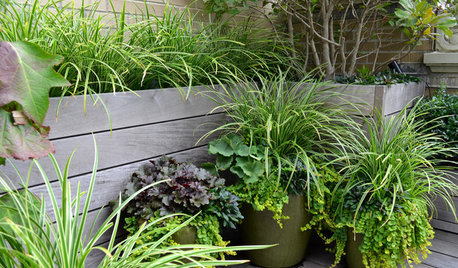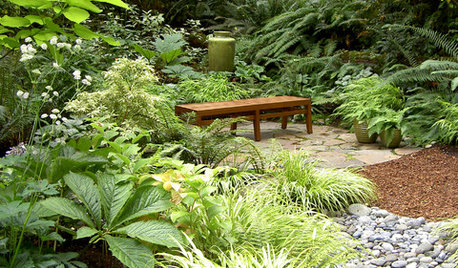Growing new grass in shady area with high clay content soil
ranger481vs
12 years ago
Related Stories

GARDENING GUIDESHow to Stop Worrying and Start Loving Clay Soil
Clay has many more benefits than you might imagine
Full Story
GARDENING GUIDESGardening Solutions for Heavy Clay Soils
What’s a gardener to do with soil that’s easily compacted and has poor drainage? Find out here
Full Story
GARDENING GUIDES10 Solutions for Soggy Soil
If a too-wet garden is raining on your parade, try these water-loving plants and other ideas for handling all of that H2O
Full Story
GARDENING GUIDESGet the Dirt on Your Garden’s Soil
Understand how your soil supports your plants so you can ensure your garden’s success
Full Story
PLANTING IDEASCreate High-Impact Container Gardens With Grasses
When it comes to adding drama, texture and panache to a pot, these strappy species are hard to beat
Full Story
FARM YOUR YARDHow to Get Good Soil for Your Edible Garden
The nutrients in your soil feed the plants that feed you. Here are tips on getting it right — just in time for planting season
Full Story
LANDSCAPE DESIGNHow to Shape a Rain Garden and Create the Right Soil for It
Learn how to grade, lay out and amend the soil in your rain garden to support your plants
Full Story
GARDENING GUIDESGardening Solutions for Dry, Sandy Soils
Has your desert or beachy site withered your gardening creativity? Try these ideas for a beautiful, easy-care landscape
Full Story
GARDENING GUIDESGreat Garden Combo: 6 Beautiful Plants for a Shady, Wet Site
Transform a shade garden with moisture-loving golden grasses, textural leaves and a sprinkling of flowers
Full Story
GARDENING GUIDES10 Top California Native Plants, Trees and Grasses
Enjoy a fuss-free, water-wise garden in the Golden State by growing plants naturally in tune with the climate and wildlife
Full StoryMore Discussions




goren
dchall_san_antonio
Related Professionals
West Milford Landscape Architects & Landscape Designers · Edmond Landscape Architects & Landscape Designers · Fort Lee Landscape Architects & Landscape Designers · East Lake-Orient Park Landscape Contractors · Emmaus Landscape Contractors · Indianapolis Landscape Contractors · Oak Harbor Landscape Contractors · Plymouth Landscape Contractors · San Antonio Landscape Contractors · Seven Hills Landscape Contractors · Vashon Landscape Contractors · Wethersfield Landscape Contractors · Casselberry Landscape Contractors · Jericho Swimming Pool Builders · Newman Swimming Pool Buildersranger481vsOriginal Author
ranger481vsOriginal Author